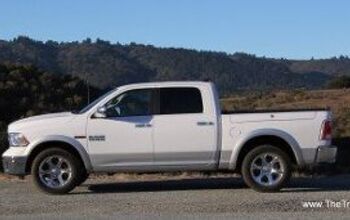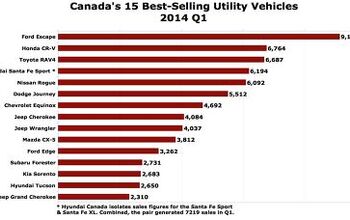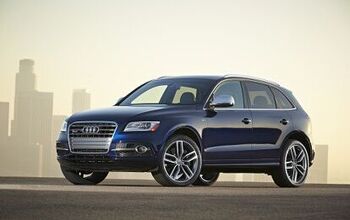Cain's Segments April 2014: German Luxury SUVs
It’s not as though consumers hadn’t experienced doses of luxury in their SUVs before the Mercedes-Benz ML, Lexus RX, and Lincoln Navigator began pushing an increasingly impressive wave toward shore in the late 90s. But, especially in the enthusiast community, there was some reluctance to accept the notion of such illustrious brands diving head first into a market that was going to demand perfectly balanced compromises. The traditional off-road ability we associated with SUVs couldn’t be thrust overboard in favour of road manners. Or could it?
To go along with an invasion of crossovers from premium Japanese brands, the Swedes, Detroit’s luxury duo, and an expanding Land Rover range, German brands have added a bevy of utility vehicles to ride the wave over the last decade.
And for the most part, they sell rather well.
BMW’s four X models were responsible for generating 37% of the brand’s April 2014 U.S. volume. To the benefit of BMW’s bottom line, the more costly X5 – rather than the X3 or entry-level X1 – attracts the greatest number of buyers.
With base prices between $63,000 and $118,000, the Mercedes-Benz GL enjoyed its best ever sales year in 2013. Sales this year are sliding, but Mercedes-Benz has already sold more GLs in 2014 than Lincoln will sell Navigators all year, at least at the current pace.
It goes without saying that the Cayenne is hugely important to Porsche. More than four out of every ten U.S. Porsche sales involves the Cayenne. Porsche sold more than 18,000 Cayennes in 2013, the first 18K+ sales year since 2004. The upcoming Macan will surely turn Porsche dealers into SUV specialists with a knack for selling sports cars on the side.
Without the Q5 and Q7, Audi USA would only have sold 33,263 vehicles in the first four months of 2014, 7100 fewer than Infiniti managed. Instead, these two vehicles which account for 35% of Audi’s U.S. volume helped the brand outsell Infiniti by more than 10,000 units over the last four months.
Audi’s parent company, Volkswagen, is the straggler. The Touareg’s low volume can easily be blamed on the combination of a mainstream badge and a premium price tag. Even in 2012, the Touareg’s first year above 10,000 U.S. units since 2006, Touareg sales were down 62% compared with 2004 levels. The Tiguan was supposed to be a compact challenger in the extraordinarily high-volume small crossover category, but it has not succeeded on this side of the Atlantic. You can guess what’s coming next. Gird your anti-Americanization loins.
Regardless of the successes or failures at specific brands, we all know the mission of these automakers has been altered by the drive toward premium utility vehicles. During the first four months of 2004, four of these brands marketed six SUVs, including the niche G-Wagen. BMW, Mercedes-Benz, Porsche, and Audi (which had not yet introduced the Q7) owned 4.8% of the overall new vehicle market and generated 15.5% of their sales with the X3, X5, Cayenne, Touareg, G-Class, and M-Class.
The industry had collapsed by 2009. During the first four months of that year, 12 different utility vehicle nameplates produced 21.6% of the quintet’s sales. The market share afforded to Audi, BMW, Mercedes-Benz, Porsche, and Volkswagen ran up to 6.7%.
This year, these five brands own 7.4% of the U.S. auto market. 13 different SUVs and crossovers generate 28.1% of the 379,322 volume (not including Sprinter) collected by five traditionally German brands.
Five of those vehicles – X3, X5, X6, ML, and GL – are assembled in the United States. All are currently being outsold by the Lexus RX, Acura MDX, Cadillac SRX, and Acura RDX. Five are selling less often this year than they did last year, although only three declined in April.
More by Timothy Cain
Latest Car Reviews
Read moreLatest Product Reviews
Read moreRecent Comments
- BrandX "I can charge using the 240V outlets, sure, but it’s slow."No it's not. That's what all home chargers use - 240V.
- Jalop1991 does the odometer represent itself in an analog fashion? Will the numbers roll slowly and stop wherever, or do they just blink to the next number like any old boring modern car?
- MaintenanceCosts E34 535i may be, for my money, the most desirable BMW ever built. (It's either it or the E34 M5.) Skeptical of these mods but they might be worth undoing.
- Arthur Dailey What a load of cow patties from fat cat politicians, swilling at the trough of their rich backers. Business is all for `free markets` when it benefits them. But are very quick to hold their hands out for government tax credits, tax breaks or government contracts. And business executives are unwilling to limit their power over their workers. Business executives are trained to `divide and conquer` by pitting workers against each other for raises or promotions. As for the fat cat politicians what about legislating a living wage, so workers don't have to worry about holding down multiple jobs or begging for raises? And what about actually criminally charging those who hire people who are not legally illegible to work? Remember that it is business interests who regularly lobby for greater immigration. If you are a good and fair employer, your workers will never feel the need to speak to a union. And if you are not a good employer, then hopefully 'you get the union that you deserve'.
- 28-Cars-Later Finally, something possibly maybe worth buying.






























Comments
Join the conversation
I had the displeasure of driving the lowest selling model on this list - a G-class Benz. It was an AMG model to boot. Absolutely HORRID. The thing felt like it was ready to capsize at any moment. And the chassis was completely overmatched by the engine. This was one of the very few times I've ever felt truly scared driving a car. AND a six figure sticker price.
I don't see to many SUVs in the list, mainly CUVs with a sprinkling of SUVs.